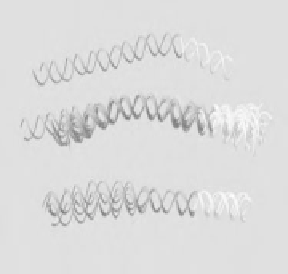Information Technology Reference
In-Depth Information
overlapping trinucleotides, and one single structural parameter
p(a)
of the trinucleotides,
constituting the enzyme-DNA contact surface, will influence the cutting rate (this is an
obvious simplification, since local effects, such as specific residue contacts between the
enzyme and the DNA molecule, are not considered); (iii) the bending propensity
p(a)
of
each trinucleotide contributes independently to the probability of DNase I cutting, P
W
. The
model thus assumes that the contribution of one element (trinucleotide) does not depend on
any other element being present or absent in the window around the cut. So P
W
for the 6 nt
window can be written as the product of the n different and assumedly independent
p(a)
probabilities:
4
P
w
p
(
a
)
i
(1)
1
Equating P
W
with the experimentally determined frequencies of cleavage, F
W
, leads to a
linear system of equations
4
¦
F
ln
p
(
a
)
(2)
w
i
1
Similar approaches have been used to extract numeric parameters from a wide variety of
different experimental data. As an extreme case, DNAseI digestibility data can be obtained
on large, continuous DNA fragments, other parameters, such as stability etc. were derived
from measurements on short oligonucleotides. Regarding the origins of the data, parameters
can be obtained either from measurement or from database statistics, such as evaluation of
3D structures or sequence data. From the computational point of view, the parameters are
represented either as tabulated values, or they are computed “on the fly”, based on the
sequence information itself.
A
B
C
Figure 6.
Output examples of the model.it
server [35].
A.
three-dimensional trajectory
model of a ~400bp
L. tarantolae
kinetoplast,
visualized using SwissPDB Viewer.
B.
Predicted conformation of 14
Zea mays
promoter regions from EPD database ORF is
shown in yellow.
C.
Superposition reveals
three conformation groups



